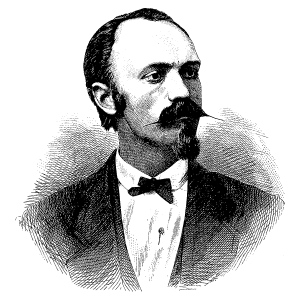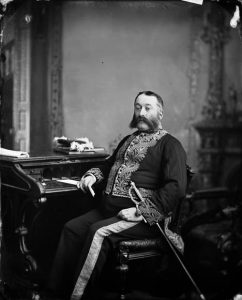Canadian History With New Eyes: The Dark Ages?
The Dark Ages & the French Wars of Religion Some time ago, I started to
Home / Our National Anthem – A Gift From Quebec
In 2005 I attended a convention hosted by the Christian Heritage Party where I sang the many verses of our National Anthem – ‘O Canada’ that reflected a rich fervent prayer to God. I thought, ‘Why isn’t the entire anthem sung publicly? These are words rich in faith and prayer.’ I actually thought that a conspiracy prevented us from knowing the ‘true’ words.
I became curious to understand the history of our National Anthem. As a result of my research, I eventually understood for the first time, the history of the national anthem or ‘Chant National’ as it was formerly known in Quebec.
Here are the original words to the Chant National and the story behind it. For our bilingual friends, consider well the words and the sentiment behind these words. Consider the composer and what he stood for. And if you don’t understand French, Google Translate might be a fairly good option for you.
O Canada! Terre de nos aïeux,
Ton front est ceint de fleurons glorieux!
Car ton bras sait porter l’épée,
Il sait porter la croix!
Ton histoire est une épopée
Des plus brillants exploits.
Et ta valeur, de foi trempée,
Protègera nos foyers et nos droits.
Protègera nos foyers et nos droits.
Verses additionnel:
Sous l’oeil de Dieu, près du fleuve géant,
Le Canadien grandit en espérant.
Il est d’une race fière,
Béni fut son berceau.
Le ciel a marqué sa carrière
Dans ce monde nouveau.
Toujours guidé par sa lumière,
Il gardera l’honneur de son drapeau,
Il gardera l’honneur de son drapeau.
De son patron, précurseur du vrai Dieu,
Il porte au front l’auréole de feu.
Ennemi de la tyrannie Mais plein de loyauté.
Il veut garder dans l’harmonie,
Sa fière liberté;
Et par l’effort de son génie,
Sur notre sol asseoir la vérité.
Sur notre sol asseoir la vérité.
Amour sacré du trône et de l’autel,
Remplis nos cœurs de ton souffle immortel!
Parmi les races étrangères,
Notre guide est la loi;
Sachons être un peuple de frères,
Sous le joug de la foi.
Et répétons, comme nos pères
Le cri vainqueur: Pour le Christ et le roi,
Le cri vainqueur: Pour le Christ et le roi.
The words to the anthem were written by Sir Adolph-Basile Routhier. The music was composed by Calixa Lavallee. Here is a little bit about who they were.

Sir Adolphe-Basile Routhier was a conservative and devout Catholic. He believed that the Church was the supreme authority in both civil and religious spheres of authority.
That Biblical worldview affected all of his life – his personal life, his legal rulings and his writing, which is reflected in his original patriotic Ode to Canada, the Chant National.

Calixa Lavallee was born near Montreal Quebec in 1842. He was a popular pianist, composer, and music teacher. He probably never thought about the providence of his song becoming the National Anthem of Canada.
In the 1800’s English Canada enjoyed two patriotic songs as their national anthems – ‘God Save The Queen’ and ‘The Maple Leaf Forever’. French Canadians desired a patriotic song with which they could identify. If you listened to The Maple Leaf Forever – which I listened to for the first time while writing this article, you will understand why.
To put this issue in a social and political context, those were very unsettling days in Quebec’s political history. Unresolved social issues eventually boiled over into the ‘Lower Canada Rebellion’ (Quebec) and the ‘Upper Canada Rebellion’ (Ontario).
In 1829, lyrics which began, ‘Sol Canadien, terre cherie’ written by Isidore Bedard with music by Theodore Molt, enjoyed short-lived success.
In 1834,‘O Canada! mon pays! Mes amours’, which was composed by Sir George Etienne Cartier with music by JB Labelle for the founding of the St.-Jean-Baptiste Society, also enjoyed short-lived popularity and success. Other attempts at a national anthem also experienced the same fate.
In 1880, the National Convention of French Canadians was slated for June 23-25 in Quebec City during the St.-Jean-Baptiste-Day celebrations. In January, the organizers had received a letter from the parish priest from Trois Rivieres – Napoleon Caron. He suggested that a competition be held to choose a national anthem for the June festivities.
In March, one of the organizers, M. Ernest Gagnon, a friend of both Sir Adolphe-Basile Routhier (the poet) and Calixa Lavalee (the renowned musician), encouraged the duo to compose the national song for expediency sake because there just was not enough time to hold a competition. Lavallee wanted to write the music FIRST before the lyrics were composed. Routhier composed the lyrics to match the metre of the music.

Because they did not want to antagonize the other organizers, Gagnon encouraged Lieutenant-Governor Robitaille to ‘officially’ commission Lavallée and Routhier to compose the national song.
The location for the performance of the first rendition was changed a few times before finally being performed.
First, the rendition was supposed to be performed at the banquet marking the conclusion of St. Jean Baptiste Day festivities in Quebec City.
Next the proposal was to perform for an exclusive gathering at the Governor General’s residence the next day in front of the Marquess of Lorne – the Governor General and son-in-law of Queen Victoria. But the organizers wanted to reach the largest possible audience.
It was therefore finally performed at the end of a banquet organized by the Congress of the St Jean Baptiste Society. It was such a crowd favourite that it quickly became popular in French Canada.
This song’s lyrics, though strongly nationalistic, contained many references to faith and the Church, celebrating the providential mission of French Canadians to North America.
It gained popularity and gradually spread across Canada with many English-language variations of the original. In 1884, Sir George-Etienne Cartier – a leader in the Lower Canada (Quebec Rebellion), Father of Confederation and first Minister of Militia and Defense in the Dominion of Canada, wrote yet another version for the Saint Jean Baptiste celebrations.
It is said that the original manuscript no longer exists, but two copies of the first edition exist.
The first edition cover is adorned by the picture of then Lieutenant General of Quebec, Theodore Robitaille, surrounded by maple leaves, and the name C. Lavallee printed across the bottom of the cover.
One copy is in the archives of the Quebec Seminary and the other in the Faculty of Music in the University of Montreal.

Author’s Note: Lynette is the owner of ChristianRoots Canada. Blogger. Publisher. Course Creator. Passionate about Canadian History from the perspective of God’s Providence.
Remember, I am NOT the last word on History. I am just a compass pointing you in the right direction. Be a Berean. Do your own research. Follow links. Challenge everything.
The Dark Ages & the French Wars of Religion Some time ago, I started to
In many places, like legislatures and schools, the Bible is considered ‘hate literature’. Counseling someone
Britain’s claim of Rupert’s Land by the Doctrine of Discovery, proved to be one of
Dominion Day had been a federal holiday that celebrated the enactment of The British North American Act which united four of Britain’s colonies – Nova Scotia, New Brunswick, Upper and Lower Canada (which became Ontario and Quebec), into a single country within the British Empire, and named that country The Dominion of Canada.